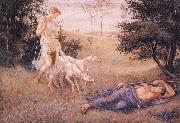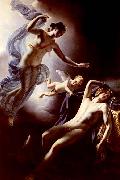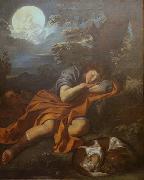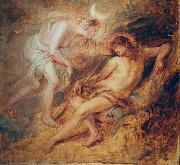Wholesale Oil Painting Reproductions No Minimum and Door to Door! |
|||||||||||
|
|
|||||||||||

|
|||||||||||
|
|
|
||||||||
All Walter Crane Oil Paintings |
||||||||
|
|
||||||||
|
|
||||||||
|
Artist Introduction: English Golden Age Illustrator, 1845-1915
English painter, illustrator, designer, writer and teacher. He showed artistic inclinations as a boy and was encouraged to draw by his father, the portrait painter and miniaturist Thomas Crane (1808-59). A series of illustrations to Tennyson's The Lady of Shalott (Cambridge, MA, Harvard U., Houghton Lib.) was shown first to Ruskin, who praised the use of colour, and then to the engraver William James Linton, to whom Crane was apprenticed in 1859. From 1859 to 1862 Crane learnt a technique of exact and economical draughtsmanship on woodblocks. |
||||||||
|
|
||||||||
|
Diana and Endymion Painting ID:: 28025 |
1883
Oil on canvas 55.2 x 78.1cm
(21 3/4 x 30 3/4 in)
McManus Galleries Dundee (mk63) |
|||||||
Height Width |
INS/CM Quality |
|||||||
|
X |
| |||||||
|
|
||||||||
All Jerome-Martin Langlois Oil Paintings |
||||||||
|
|
||||||||
|
|
||||||||
|
Artist Introduction: French Academic Painter,
1779-1838 |
||||||||
|
|
||||||||
|
|
Diana and Endymion Painting ID:: 44047 |
Oil on canvas,
318 x 211 cm |
||||||
Height Width |
INS/CM Quality |
|||||||
|
X |
| |||||||
|
|
||||||||
All Pier Francesco Mola Oil Paintings |
||||||||
|
|
||||||||
|
|
||||||||
|
Artist Introduction: (9 February 1612 - 13 May 1666) was an Italian painter of the High Baroque, mainly active around Rome.
Mola was born at Coldrerio (now in Ticino, Switzerland). At the age of four, he moved to Rome with his father Giovanni Battista, a painter. With the exception of the years 1633 - 40 and 1641 - 47, during which he resided in Venice and Bologna, respectively, he lived for the rest of his life in Rome.
His early training was with the late mannerist painter Cavalier D'Arpino, and he worked under the classicizing Francesco Albani.
His masterpiece is the fresco in the gallery of Alexander VII in the Quirinal Palace Gallery, entitled Joseph making himself known to his Brethren (1657). He made six versions of The Flight into Egypt, the earileist and best of which is the first one, The Rest on the Flight into Egypt.
He was elected Principe of the Accademia di San Luca, the Roman artists' professional association, in 1662, but his last years were neither profitable nor prolific. One of his pupils was Antonio Gherardi.
With his looser style and handling, more naturalistic palette, and interest in exploring landscape elements, Mola rebelled against the prevailing, highly-theoretical classicism of such leading 17th-century Roman painters as Andrea Sacchi.
|
||||||||
|
|
||||||||
|
|
Diana and Endymion Painting ID:: 80732 |
Date ca. 1660(1660)
Medium Oil on canvas
cjr |
||||||
Height Width |
INS/CM Quality |
|||||||
|
X |
| |||||||
|
|
||||||||
All Pier Francesco Mola Oil Paintings |
||||||||
|
|
||||||||
|
|
||||||||
|
Artist Introduction: (9 February 1612 - 13 May 1666) was an Italian painter of the High Baroque, mainly active around Rome.
Mola was born at Coldrerio (now in Ticino, Switzerland). At the age of four, he moved to Rome with his father Giovanni Battista, a painter. With the exception of the years 1633 - 40 and 1641 - 47, during which he resided in Venice and Bologna, respectively, he lived for the rest of his life in Rome.
His early training was with the late mannerist painter Cavalier D'Arpino, and he worked under the classicizing Francesco Albani.
His masterpiece is the fresco in the gallery of Alexander VII in the Quirinal Palace Gallery, entitled Joseph making himself known to his Brethren (1657). He made six versions of The Flight into Egypt, the earileist and best of which is the first one, The Rest on the Flight into Egypt.
He was elected Principe of the Accademia di San Luca, the Roman artists' professional association, in 1662, but his last years were neither profitable nor prolific. One of his pupils was Antonio Gherardi.
With his looser style and handling, more naturalistic palette, and interest in exploring landscape elements, Mola rebelled against the prevailing, highly-theoretical classicism of such leading 17th-century Roman painters as Andrea Sacchi.
|
||||||||
|
|
||||||||
|
|
Diana and Endymion Painting ID:: 84916 |
. 1660(1660)
Medium Oil on canvas
cyf |
||||||
Height Width |
INS/CM Quality |
|||||||
|
X |
| |||||||
|
|
||||||||
All Peter Paul Rubens Oil Paintings |
||||||||
|
|
||||||||
|
|
||||||||
|
Artist Introduction: Flemish Baroque Era Painter, 1577-1640
Peter Paul Rubens (June 28, 1577 ?C May 30, 1640) was a prolific seventeenth-century Flemish Baroque painter, and a proponent of an exuberant Baroque style that emphasized movement, color, and sensuality. He is well-known for his Counter-Reformation altarpieces, portraits, landscapes, and history paintings of mythological and allegorical subjects.
In addition to running a large studio in Antwerp which produced paintings popular with nobility and art collectors throughout Europe, Rubens was a classically-educated humanist scholar, art collector, and diplomat who was knighted by both Philip IV, king of Spain, and Charles I, king of England.
Rubens was a prolific artist. His commissioned works were mostly religious subjects, "history" paintings, which included mythological subjects, and hunt scenes. He painted portraits, especially of friends, and self-portraits, and in later life painted several landscapes. Rubens designed tapestries and prints, as well as his own house. He also oversaw the ephemeral decorations of the Joyous Entry into Antwerp by the Cardinal-Infante Ferdinand in 1635.
His drawings are mostly extremely forceful but not detailed; he also made great use of oil sketches as preparatory studies. He was one of the last major artists to make consistent use of wooden panels as a support medium, even for very large works, but he used canvas as well, especially when the work needed to be sent a long distance. For altarpieces he sometimes painted on slate to reduce reflection problems.
His fondness of painting full-figured women gave rise to the terms 'Rubensian' or 'Rubenesque' for plus-sized women. The term 'Rubensiaans' is also commonly used in Dutch to denote such women. |
||||||||
|
|
||||||||
|
|
Diana and Endymion Painting ID:: 87107 |
1636(1636)
Medium Oil on wood
Dimensions 28.6 x 26.6 cm (11.3 x 10.5 in)
cyf |
||||||
Height Width |
INS/CM Quality |
|||||||
|
X |
| |||||||
|
|
||||||||
|
Prev Next
|
||||||||
|
|
||||||||
|
Related Paintings to Peter Paul Rubens :. |
||||||||
|
|
||||||||
|
CONTACT US |





